HLT54115 Diploma of Nursing: CCS101 Assessment 1 - Case Study
VerifiedAdded on 2022/08/22
|11
|2016
|22
Homework Assignment
AI Summary
This document presents a completed assessment for the CCS101 Communicating for Cultural Safety course, part of the HLT54115 Diploma of Nursing program. The assessment is a case study analysis, addressing various aspects of effective communication in a healthcare setting. It covers topics such as physical, social, and cultural diversity impacting communication, behaviors that facilitate or inhibit communication, the appropriate use of medical and lay terminology, and the importance of active listening, conflict resolution, and interpreter services. The assessment also emphasizes the principles of nursing documentation, effective information transfer during clinical handovers, the meaning of therapeutic relationships, and the role of advocacy in nursing. Furthermore, it addresses the ethical and legal requirements of using social media, email etiquette, and the importance of respect and value for diversity and inclusiveness. The document provides definitions and examples related to cultural awareness, cultural safety, and cultural competence and also highlights the use of online resources for evidence-based information.
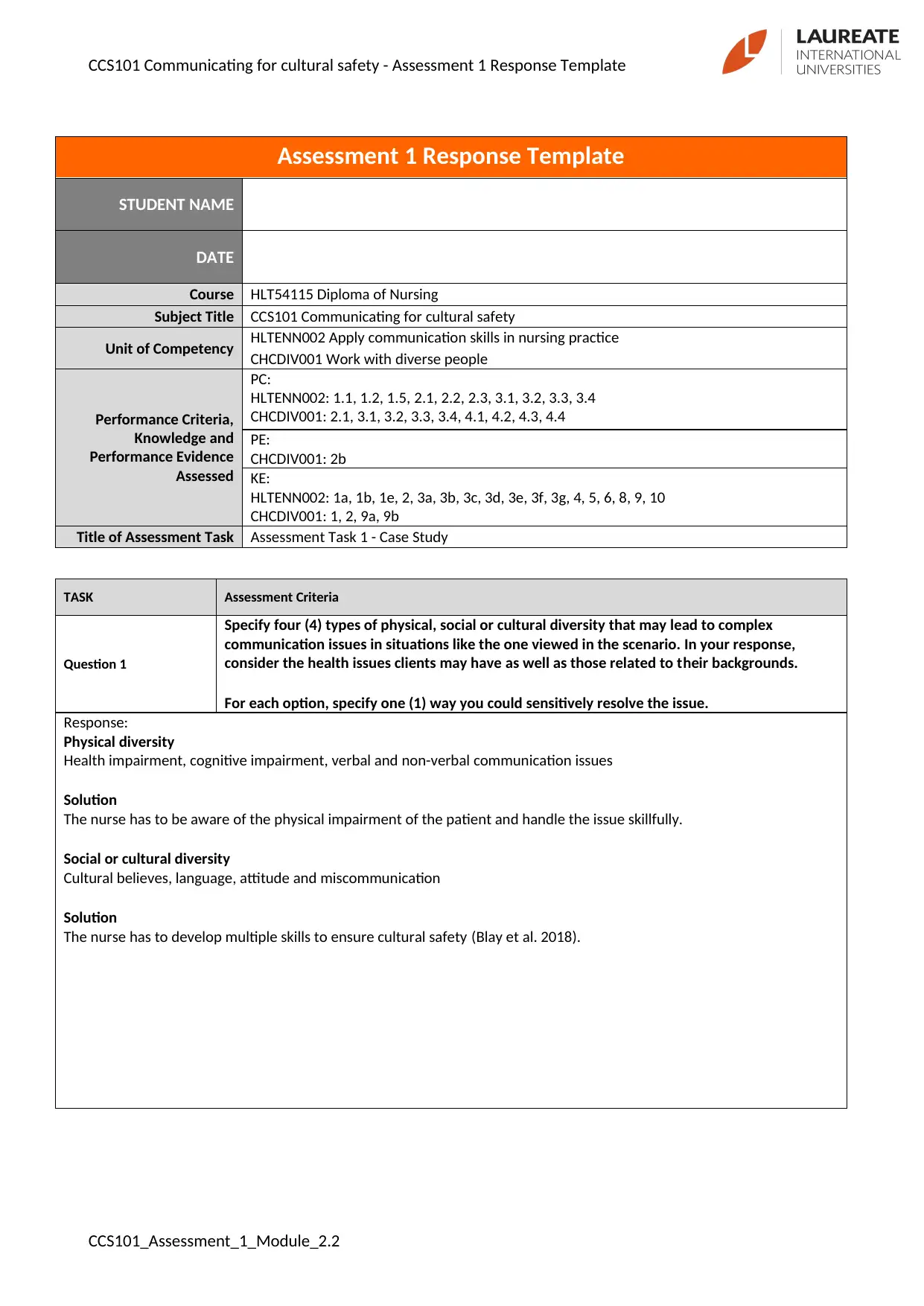
CCS101 Communicating for cultural safety - Assessment 1 Response Template
Assessment 1 Response Template
STUDENT NAME
DATE
Course HLT54115 Diploma of Nursing
Subject Title CCS101 Communicating for cultural safety
Unit of Competency HLTENN002 Apply communication skills in nursing practice
CHCDIV001 Work with diverse people
Performance Criteria,
Knowledge and
Performance Evidence
Assessed
PC:
HLTENN002: 1.1, 1.2, 1.5, 2.1, 2.2, 2.3, 3.1, 3.2, 3.3, 3.4
CHCDIV001: 2.1, 3.1, 3.2, 3.3, 3.4, 4.1, 4.2, 4.3, 4.4
PE:
CHCDIV001: 2b
KE:
HLTENN002: 1a, 1b, 1e, 2, 3a, 3b, 3c, 3d, 3e, 3f, 3g, 4, 5, 6, 8, 9, 10
CHCDIV001: 1, 2, 9a, 9b
Title of Assessment Task Assessment Task 1 - Case Study
TASK Assessment Criteria
Question 1
Specify four (4) types of physical, social or cultural diversity that may lead to complex
communication issues in situations like the one viewed in the scenario. In your response,
consider the health issues clients may have as well as those related to their backgrounds.
For each option, specify one (1) way you could sensitively resolve the issue.
Response:
Physical diversity
Health impairment, cognitive impairment, verbal and non-verbal communication issues
Solution
The nurse has to be aware of the physical impairment of the patient and handle the issue skillfully.
Social or cultural diversity
Cultural believes, language, attitude and miscommunication
Solution
The nurse has to develop multiple skills to ensure cultural safety (Blay et al. 2018).
CCS101_Assessment_1_Module_2.2
Assessment 1 Response Template
STUDENT NAME
DATE
Course HLT54115 Diploma of Nursing
Subject Title CCS101 Communicating for cultural safety
Unit of Competency HLTENN002 Apply communication skills in nursing practice
CHCDIV001 Work with diverse people
Performance Criteria,
Knowledge and
Performance Evidence
Assessed
PC:
HLTENN002: 1.1, 1.2, 1.5, 2.1, 2.2, 2.3, 3.1, 3.2, 3.3, 3.4
CHCDIV001: 2.1, 3.1, 3.2, 3.3, 3.4, 4.1, 4.2, 4.3, 4.4
PE:
CHCDIV001: 2b
KE:
HLTENN002: 1a, 1b, 1e, 2, 3a, 3b, 3c, 3d, 3e, 3f, 3g, 4, 5, 6, 8, 9, 10
CHCDIV001: 1, 2, 9a, 9b
Title of Assessment Task Assessment Task 1 - Case Study
TASK Assessment Criteria
Question 1
Specify four (4) types of physical, social or cultural diversity that may lead to complex
communication issues in situations like the one viewed in the scenario. In your response,
consider the health issues clients may have as well as those related to their backgrounds.
For each option, specify one (1) way you could sensitively resolve the issue.
Response:
Physical diversity
Health impairment, cognitive impairment, verbal and non-verbal communication issues
Solution
The nurse has to be aware of the physical impairment of the patient and handle the issue skillfully.
Social or cultural diversity
Cultural believes, language, attitude and miscommunication
Solution
The nurse has to develop multiple skills to ensure cultural safety (Blay et al. 2018).
CCS101_Assessment_1_Module_2.2
Paraphrase This Document
Need a fresh take? Get an instant paraphrase of this document with our AI Paraphraser
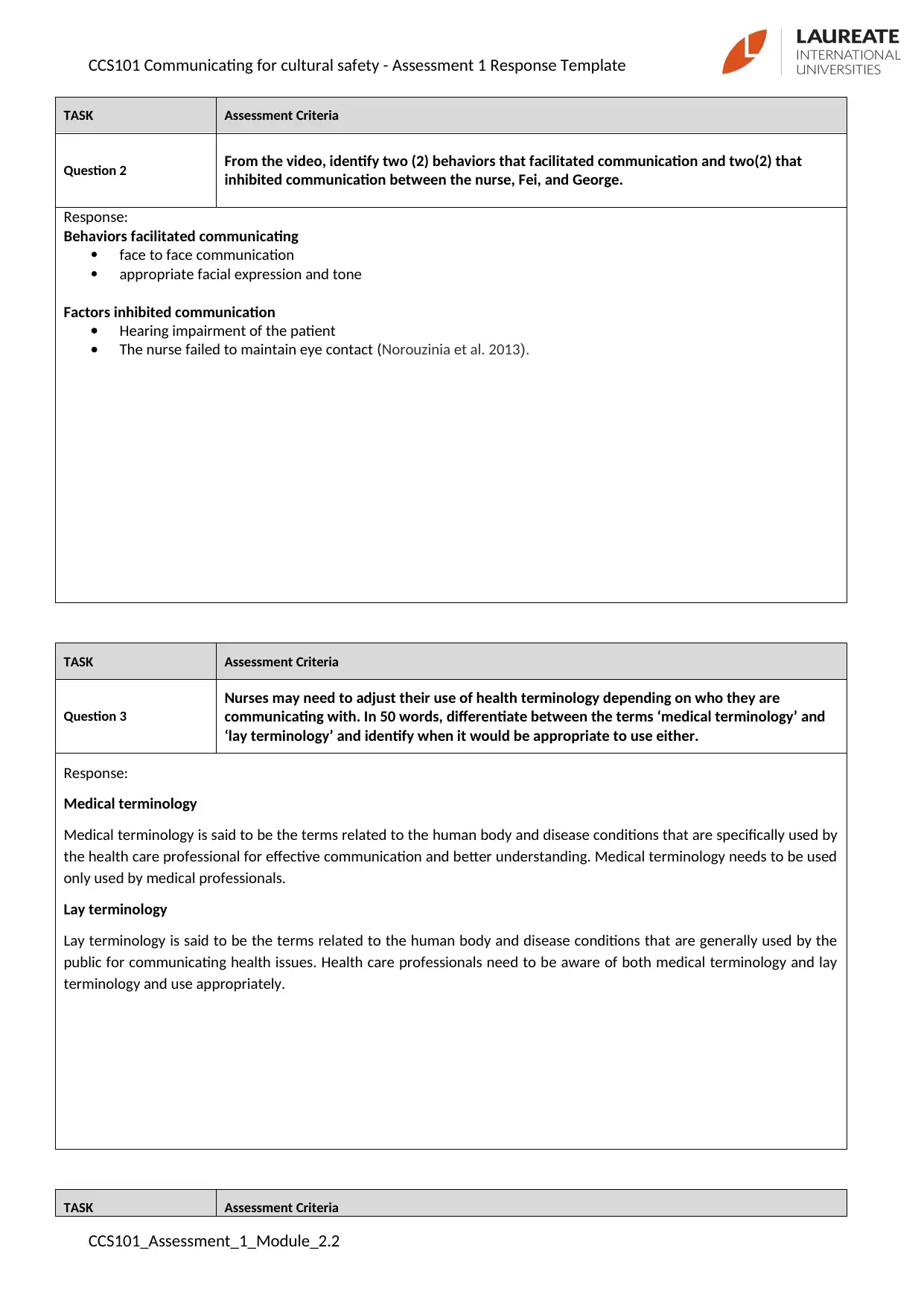
CCS101 Communicating for cultural safety - Assessment 1 Response Template
TASK Assessment Criteria
Question 2 From the video, identify two (2) behaviors that facilitated communication and two(2) that
inhibited communication between the nurse, Fei, and George.
Response:
Behaviors facilitated communicating
face to face communication
appropriate facial expression and tone
Factors inhibited communication
Hearing impairment of the patient
The nurse failed to maintain eye contact (Norouzinia et al. 2013).
TASK Assessment Criteria
Question 3
Nurses may need to adjust their use of health terminology depending on who they are
communicating with. In 50 words, differentiate between the terms ‘medical terminology’ and
‘lay terminology’ and identify when it would be appropriate to use either.
Response:
Medical terminology
Medical terminology is said to be the terms related to the human body and disease conditions that are specifically used by
the health care professional for effective communication and better understanding. Medical terminology needs to be used
only used by medical professionals.
Lay terminology
Lay terminology is said to be the terms related to the human body and disease conditions that are generally used by the
public for communicating health issues. Health care professionals need to be aware of both medical terminology and lay
terminology and use appropriately.
TASK Assessment Criteria
CCS101_Assessment_1_Module_2.2
TASK Assessment Criteria
Question 2 From the video, identify two (2) behaviors that facilitated communication and two(2) that
inhibited communication between the nurse, Fei, and George.
Response:
Behaviors facilitated communicating
face to face communication
appropriate facial expression and tone
Factors inhibited communication
Hearing impairment of the patient
The nurse failed to maintain eye contact (Norouzinia et al. 2013).
TASK Assessment Criteria
Question 3
Nurses may need to adjust their use of health terminology depending on who they are
communicating with. In 50 words, differentiate between the terms ‘medical terminology’ and
‘lay terminology’ and identify when it would be appropriate to use either.
Response:
Medical terminology
Medical terminology is said to be the terms related to the human body and disease conditions that are specifically used by
the health care professional for effective communication and better understanding. Medical terminology needs to be used
only used by medical professionals.
Lay terminology
Lay terminology is said to be the terms related to the human body and disease conditions that are generally used by the
public for communicating health issues. Health care professionals need to be aware of both medical terminology and lay
terminology and use appropriately.
TASK Assessment Criteria
CCS101_Assessment_1_Module_2.2
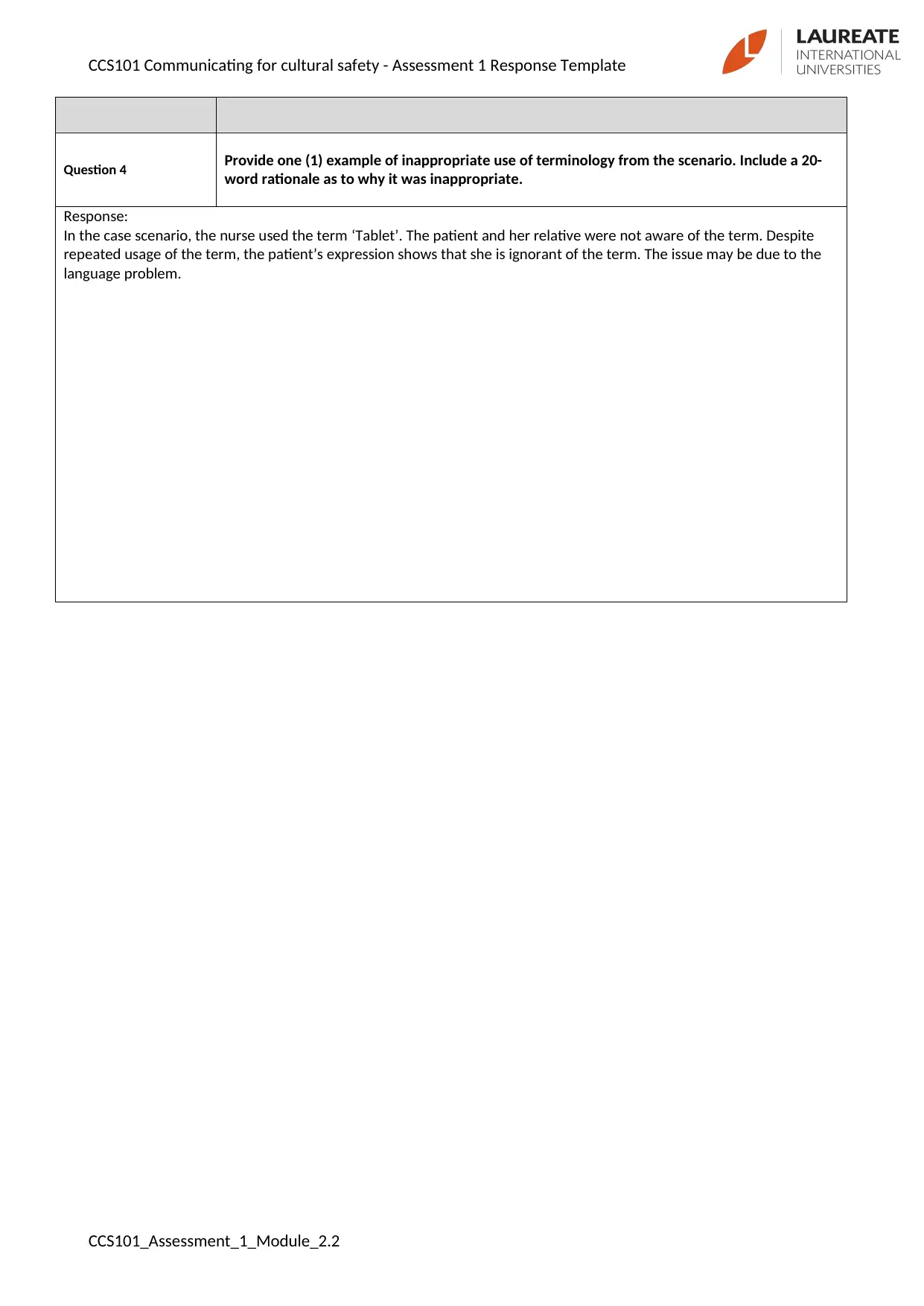
CCS101 Communicating for cultural safety - Assessment 1 Response Template
Question 4 Provide one (1) example of inappropriate use of terminology from the scenario. Include a 20-
word rationale as to why it was inappropriate.
Response:
In the case scenario, the nurse used the term ‘Tablet’. The patient and her relative were not aware of the term. Despite
repeated usage of the term, the patient’s expression shows that she is ignorant of the term. The issue may be due to the
language problem.
CCS101_Assessment_1_Module_2.2
Question 4 Provide one (1) example of inappropriate use of terminology from the scenario. Include a 20-
word rationale as to why it was inappropriate.
Response:
In the case scenario, the nurse used the term ‘Tablet’. The patient and her relative were not aware of the term. Despite
repeated usage of the term, the patient’s expression shows that she is ignorant of the term. The issue may be due to the
language problem.
CCS101_Assessment_1_Module_2.2
⊘ This is a preview!⊘
Do you want full access?
Subscribe today to unlock all pages.

Trusted by 1+ million students worldwide
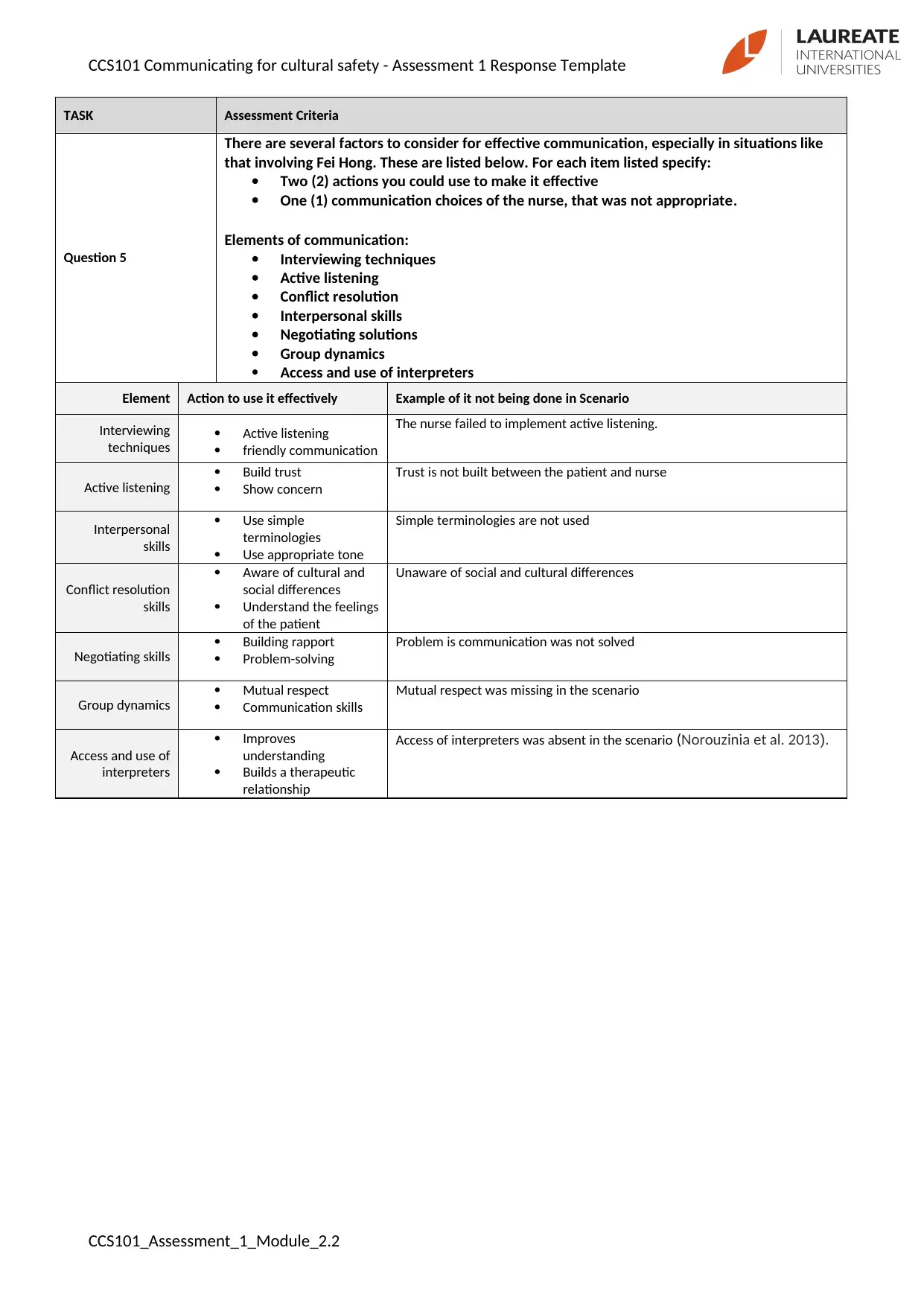
CCS101 Communicating for cultural safety - Assessment 1 Response Template
TASK Assessment Criteria
Question 5
There are several factors to consider for effective communication, especially in situations like
that involving Fei Hong. These are listed below. For each item listed specify:
Two (2) actions you could use to make it effective
One (1) communication choices of the nurse, that was not appropriate.
Elements of communication:
Interviewing techniques
Active listening
Conflict resolution
Interpersonal skills
Negotiating solutions
Group dynamics
Access and use of interpreters
Element Action to use it effectively Example of it not being done in Scenario
Interviewing
techniques
Active listening
friendly communication
The nurse failed to implement active listening.
Active listening
Build trust
Show concern
Trust is not built between the patient and nurse
Interpersonal
skills
Use simple
terminologies
Use appropriate tone
Simple terminologies are not used
Conflict resolution
skills
Aware of cultural and
social differences
Understand the feelings
of the patient
Unaware of social and cultural differences
Negotiating skills
Building rapport
Problem-solving
Problem is communication was not solved
Group dynamics
Mutual respect
Communication skills
Mutual respect was missing in the scenario
Access and use of
interpreters
Improves
understanding
Builds a therapeutic
relationship
Access of interpreters was absent in the scenario (Norouzinia et al. 2013).
CCS101_Assessment_1_Module_2.2
TASK Assessment Criteria
Question 5
There are several factors to consider for effective communication, especially in situations like
that involving Fei Hong. These are listed below. For each item listed specify:
Two (2) actions you could use to make it effective
One (1) communication choices of the nurse, that was not appropriate.
Elements of communication:
Interviewing techniques
Active listening
Conflict resolution
Interpersonal skills
Negotiating solutions
Group dynamics
Access and use of interpreters
Element Action to use it effectively Example of it not being done in Scenario
Interviewing
techniques
Active listening
friendly communication
The nurse failed to implement active listening.
Active listening
Build trust
Show concern
Trust is not built between the patient and nurse
Interpersonal
skills
Use simple
terminologies
Use appropriate tone
Simple terminologies are not used
Conflict resolution
skills
Aware of cultural and
social differences
Understand the feelings
of the patient
Unaware of social and cultural differences
Negotiating skills
Building rapport
Problem-solving
Problem is communication was not solved
Group dynamics
Mutual respect
Communication skills
Mutual respect was missing in the scenario
Access and use of
interpreters
Improves
understanding
Builds a therapeutic
relationship
Access of interpreters was absent in the scenario (Norouzinia et al. 2013).
CCS101_Assessment_1_Module_2.2
Paraphrase This Document
Need a fresh take? Get an instant paraphrase of this document with our AI Paraphraser
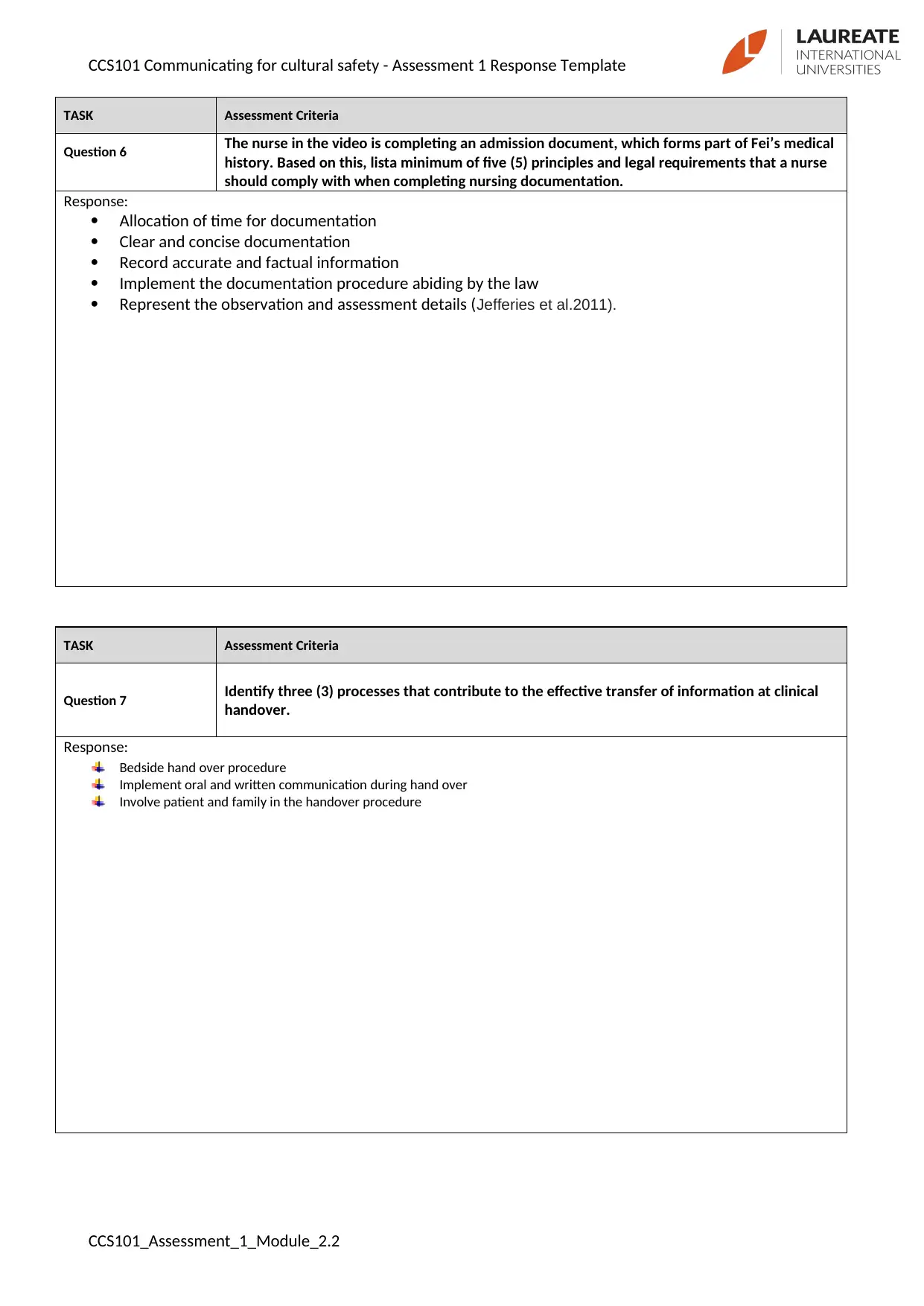
CCS101 Communicating for cultural safety - Assessment 1 Response Template
TASK Assessment Criteria
Question 6 The nurse in the video is completing an admission document, which forms part of Fei’s medical
history. Based on this, lista minimum of five (5) principles and legal requirements that a nurse
should comply with when completing nursing documentation.
Response:
Allocation of time for documentation
Clear and concise documentation
Record accurate and factual information
Implement the documentation procedure abiding by the law
Represent the observation and assessment details (Jefferies et al.2011).
TASK Assessment Criteria
Question 7 Identify three (3) processes that contribute to the effective transfer of information at clinical
handover.
Response:
Bedside hand over procedure
Implement oral and written communication during hand over
Involve patient and family in the handover procedure
CCS101_Assessment_1_Module_2.2
TASK Assessment Criteria
Question 6 The nurse in the video is completing an admission document, which forms part of Fei’s medical
history. Based on this, lista minimum of five (5) principles and legal requirements that a nurse
should comply with when completing nursing documentation.
Response:
Allocation of time for documentation
Clear and concise documentation
Record accurate and factual information
Implement the documentation procedure abiding by the law
Represent the observation and assessment details (Jefferies et al.2011).
TASK Assessment Criteria
Question 7 Identify three (3) processes that contribute to the effective transfer of information at clinical
handover.
Response:
Bedside hand over procedure
Implement oral and written communication during hand over
Involve patient and family in the handover procedure
CCS101_Assessment_1_Module_2.2
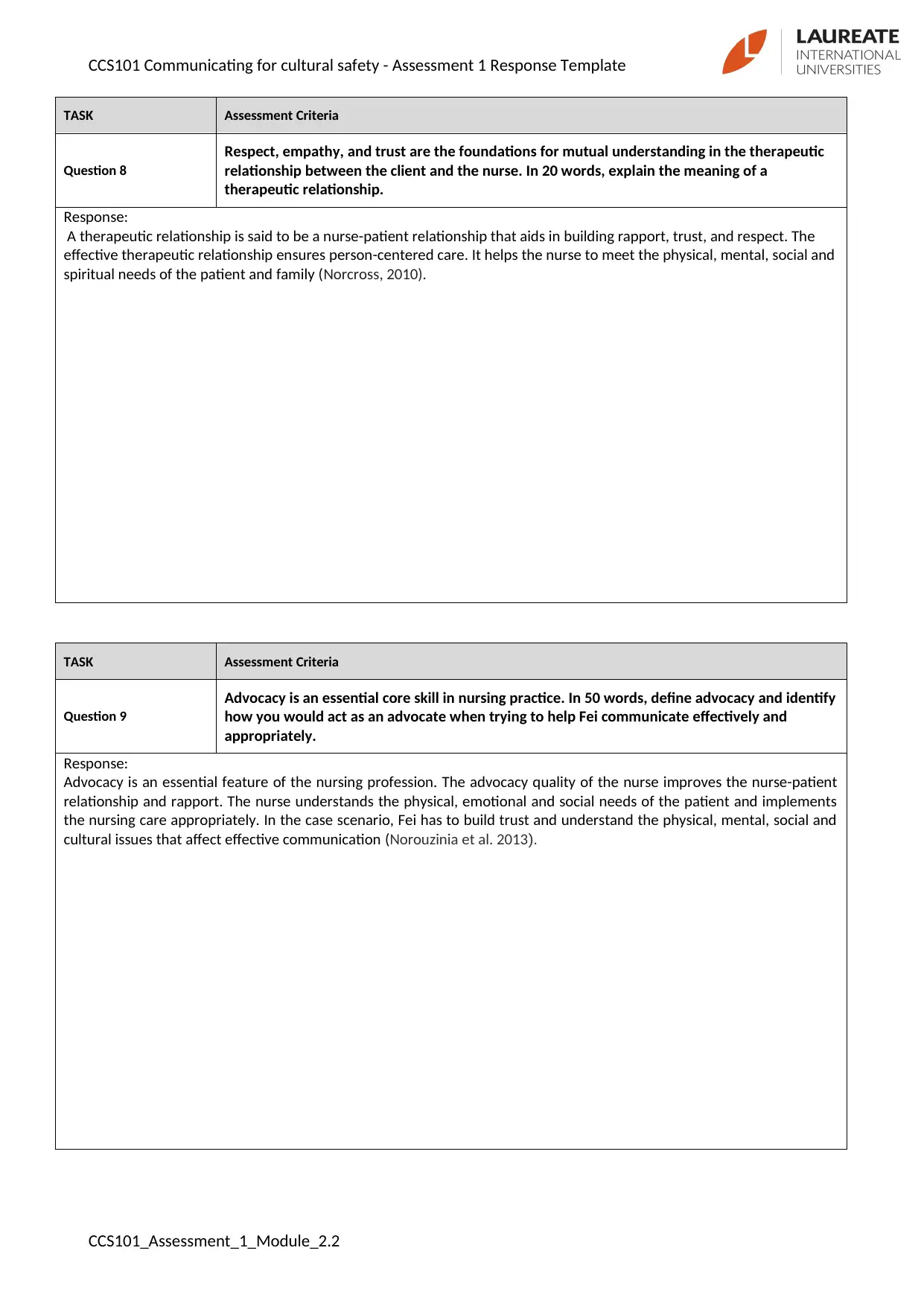
CCS101 Communicating for cultural safety - Assessment 1 Response Template
TASK Assessment Criteria
Question 8
Respect, empathy, and trust are the foundations for mutual understanding in the therapeutic
relationship between the client and the nurse. In 20 words, explain the meaning of a
therapeutic relationship.
Response:
A therapeutic relationship is said to be a nurse-patient relationship that aids in building rapport, trust, and respect. The
effective therapeutic relationship ensures person-centered care. It helps the nurse to meet the physical, mental, social and
spiritual needs of the patient and family (Norcross, 2010).
TASK Assessment Criteria
Question 9
Advocacy is an essential core skill in nursing practice. In 50 words, define advocacy and identify
how you would act as an advocate when trying to help Fei communicate effectively and
appropriately.
Response:
Advocacy is an essential feature of the nursing profession. The advocacy quality of the nurse improves the nurse-patient
relationship and rapport. The nurse understands the physical, emotional and social needs of the patient and implements
the nursing care appropriately. In the case scenario, Fei has to build trust and understand the physical, mental, social and
cultural issues that affect effective communication (Norouzinia et al. 2013).
CCS101_Assessment_1_Module_2.2
TASK Assessment Criteria
Question 8
Respect, empathy, and trust are the foundations for mutual understanding in the therapeutic
relationship between the client and the nurse. In 20 words, explain the meaning of a
therapeutic relationship.
Response:
A therapeutic relationship is said to be a nurse-patient relationship that aids in building rapport, trust, and respect. The
effective therapeutic relationship ensures person-centered care. It helps the nurse to meet the physical, mental, social and
spiritual needs of the patient and family (Norcross, 2010).
TASK Assessment Criteria
Question 9
Advocacy is an essential core skill in nursing practice. In 50 words, define advocacy and identify
how you would act as an advocate when trying to help Fei communicate effectively and
appropriately.
Response:
Advocacy is an essential feature of the nursing profession. The advocacy quality of the nurse improves the nurse-patient
relationship and rapport. The nurse understands the physical, emotional and social needs of the patient and implements
the nursing care appropriately. In the case scenario, Fei has to build trust and understand the physical, mental, social and
cultural issues that affect effective communication (Norouzinia et al. 2013).
CCS101_Assessment_1_Module_2.2
⊘ This is a preview!⊘
Do you want full access?
Subscribe today to unlock all pages.

Trusted by 1+ million students worldwide
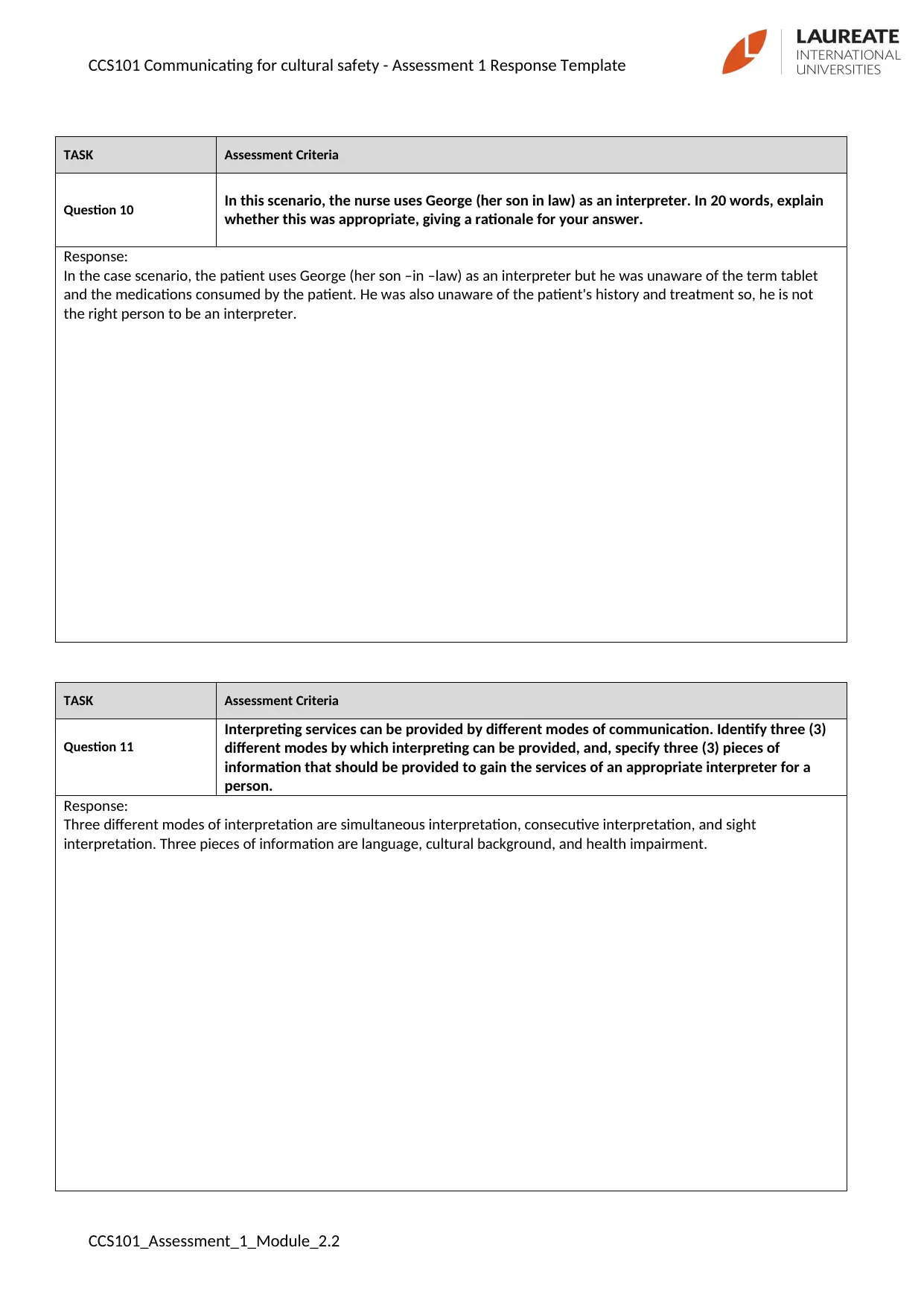
CCS101 Communicating for cultural safety - Assessment 1 Response Template
TASK Assessment Criteria
Question 10 In this scenario, the nurse uses George (her son in law) as an interpreter. In 20 words, explain
whether this was appropriate, giving a rationale for your answer.
Response:
In the case scenario, the patient uses George (her son –in –law) as an interpreter but he was unaware of the term tablet
and the medications consumed by the patient. He was also unaware of the patient's history and treatment so, he is not
the right person to be an interpreter.
TASK Assessment Criteria
Question 11
Interpreting services can be provided by different modes of communication. Identify three (3)
different modes by which interpreting can be provided, and, specify three (3) pieces of
information that should be provided to gain the services of an appropriate interpreter for a
person.
Response:
Three different modes of interpretation are simultaneous interpretation, consecutive interpretation, and sight
interpretation. Three pieces of information are language, cultural background, and health impairment.
CCS101_Assessment_1_Module_2.2
TASK Assessment Criteria
Question 10 In this scenario, the nurse uses George (her son in law) as an interpreter. In 20 words, explain
whether this was appropriate, giving a rationale for your answer.
Response:
In the case scenario, the patient uses George (her son –in –law) as an interpreter but he was unaware of the term tablet
and the medications consumed by the patient. He was also unaware of the patient's history and treatment so, he is not
the right person to be an interpreter.
TASK Assessment Criteria
Question 11
Interpreting services can be provided by different modes of communication. Identify three (3)
different modes by which interpreting can be provided, and, specify three (3) pieces of
information that should be provided to gain the services of an appropriate interpreter for a
person.
Response:
Three different modes of interpretation are simultaneous interpretation, consecutive interpretation, and sight
interpretation. Three pieces of information are language, cultural background, and health impairment.
CCS101_Assessment_1_Module_2.2
Paraphrase This Document
Need a fresh take? Get an instant paraphrase of this document with our AI Paraphraser
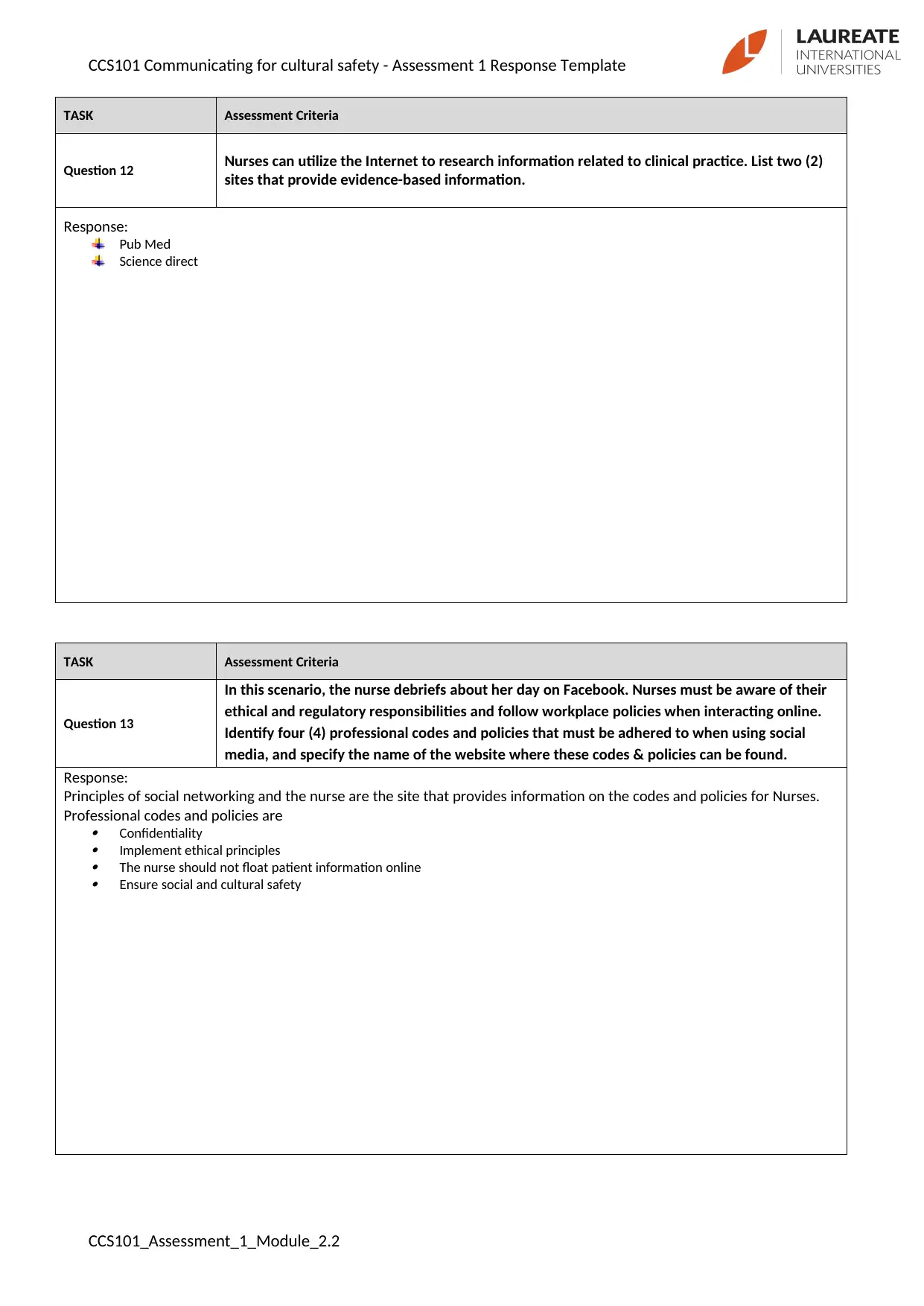
CCS101 Communicating for cultural safety - Assessment 1 Response Template
TASK Assessment Criteria
Question 12 Nurses can utilize the Internet to research information related to clinical practice. List two (2)
sites that provide evidence-based information.
Response:
Pub Med
Science direct
TASK Assessment Criteria
Question 13
In this scenario, the nurse debriefs about her day on Facebook. Nurses must be aware of their
ethical and regulatory responsibilities and follow workplace policies when interacting online.
Identify four (4) professional codes and policies that must be adhered to when using social
media, and specify the name of the website where these codes & policies can be found.
Response:
Principles of social networking and the nurse are the site that provides information on the codes and policies for Nurses.
Professional codes and policies are Confidentiality
Implement ethical principles
The nurse should not float patient information online
Ensure social and cultural safety
CCS101_Assessment_1_Module_2.2
TASK Assessment Criteria
Question 12 Nurses can utilize the Internet to research information related to clinical practice. List two (2)
sites that provide evidence-based information.
Response:
Pub Med
Science direct
TASK Assessment Criteria
Question 13
In this scenario, the nurse debriefs about her day on Facebook. Nurses must be aware of their
ethical and regulatory responsibilities and follow workplace policies when interacting online.
Identify four (4) professional codes and policies that must be adhered to when using social
media, and specify the name of the website where these codes & policies can be found.
Response:
Principles of social networking and the nurse are the site that provides information on the codes and policies for Nurses.
Professional codes and policies are Confidentiality
Implement ethical principles
The nurse should not float patient information online
Ensure social and cultural safety
CCS101_Assessment_1_Module_2.2
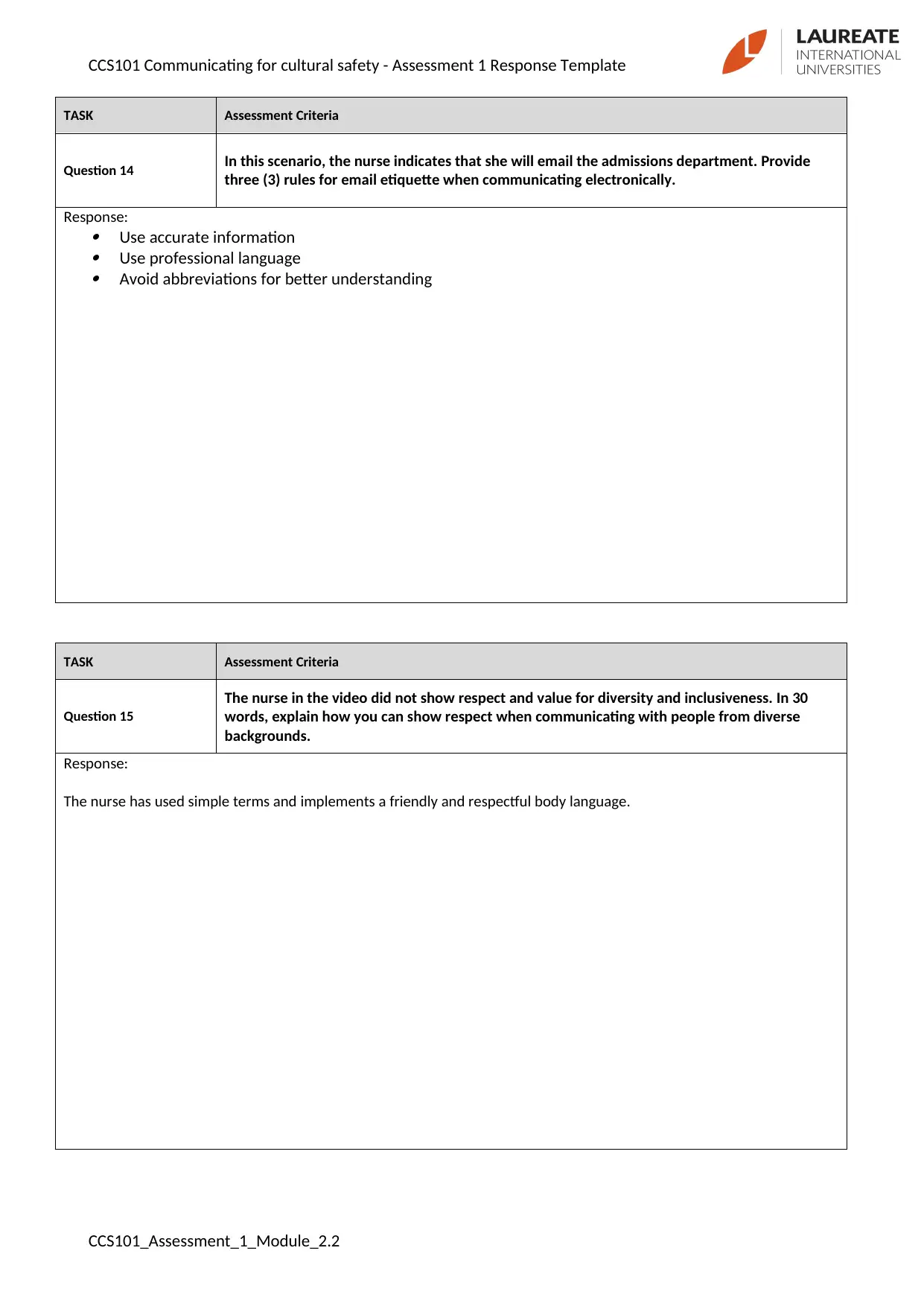
CCS101 Communicating for cultural safety - Assessment 1 Response Template
TASK Assessment Criteria
Question 14 In this scenario, the nurse indicates that she will email the admissions department. Provide
three (3) rules for email etiquette when communicating electronically.
Response: Use accurate information Use professional language Avoid abbreviations for better understanding
TASK Assessment Criteria
Question 15
The nurse in the video did not show respect and value for diversity and inclusiveness. In 30
words, explain how you can show respect when communicating with people from diverse
backgrounds.
Response:
The nurse has used simple terms and implements a friendly and respectful body language.
CCS101_Assessment_1_Module_2.2
TASK Assessment Criteria
Question 14 In this scenario, the nurse indicates that she will email the admissions department. Provide
three (3) rules for email etiquette when communicating electronically.
Response: Use accurate information Use professional language Avoid abbreviations for better understanding
TASK Assessment Criteria
Question 15
The nurse in the video did not show respect and value for diversity and inclusiveness. In 30
words, explain how you can show respect when communicating with people from diverse
backgrounds.
Response:
The nurse has used simple terms and implements a friendly and respectful body language.
CCS101_Assessment_1_Module_2.2
⊘ This is a preview!⊘
Do you want full access?
Subscribe today to unlock all pages.

Trusted by 1+ million students worldwide
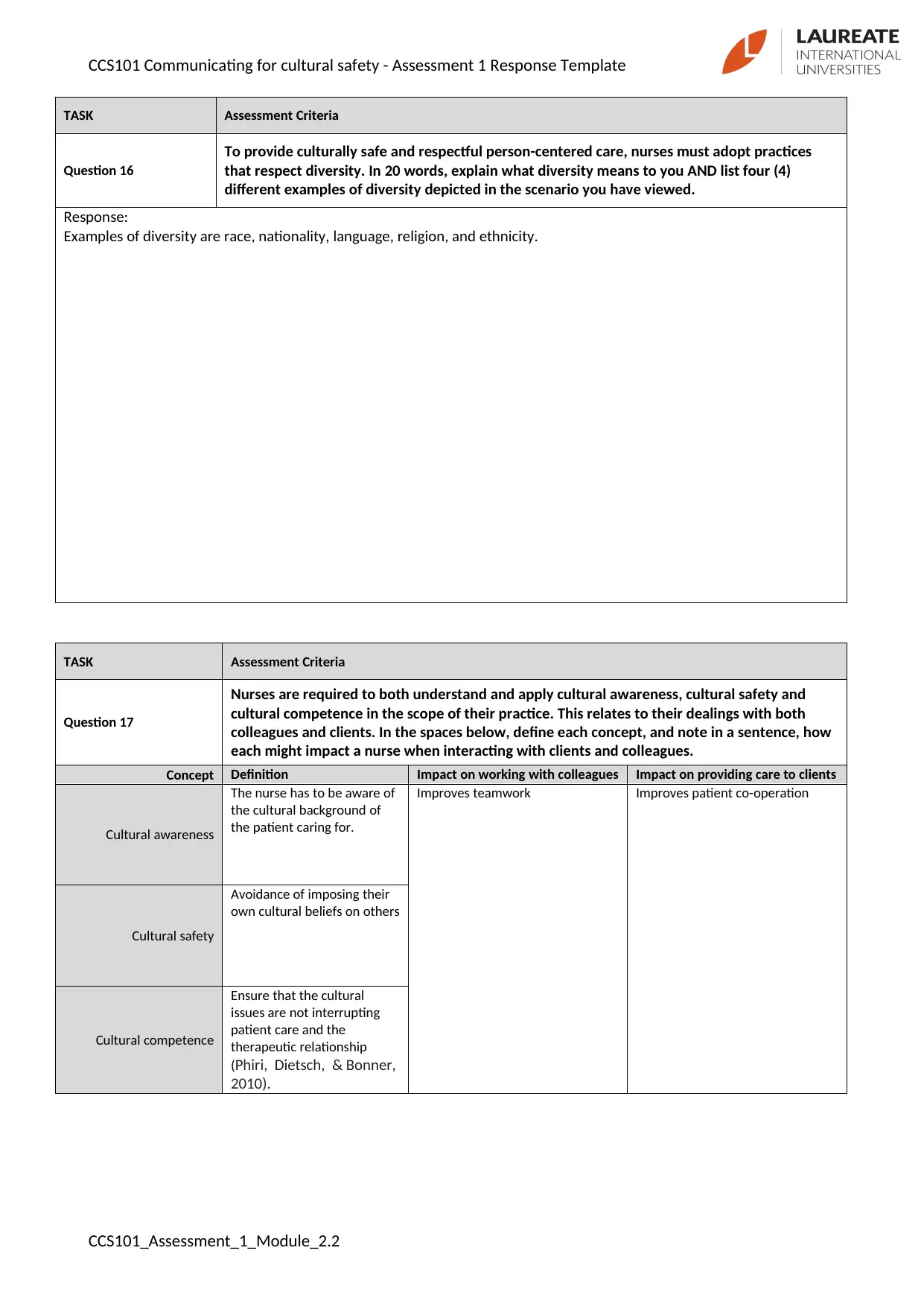
CCS101 Communicating for cultural safety - Assessment 1 Response Template
TASK Assessment Criteria
Question 16
To provide culturally safe and respectful person-centered care, nurses must adopt practices
that respect diversity. In 20 words, explain what diversity means to you AND list four (4)
different examples of diversity depicted in the scenario you have viewed.
Response:
Examples of diversity are race, nationality, language, religion, and ethnicity.
TASK Assessment Criteria
Question 17
Nurses are required to both understand and apply cultural awareness, cultural safety and
cultural competence in the scope of their practice. This relates to their dealings with both
colleagues and clients. In the spaces below, define each concept, and note in a sentence, how
each might impact a nurse when interacting with clients and colleagues.
Concept Definition Impact on working with colleagues Impact on providing care to clients
Cultural awareness
The nurse has to be aware of
the cultural background of
the patient caring for.
Improves teamwork Improves patient co-operation
Cultural safety
Avoidance of imposing their
own cultural beliefs on others
Cultural competence
Ensure that the cultural
issues are not interrupting
patient care and the
therapeutic relationship
(Phiri, Dietsch, & Bonner,
2010).
CCS101_Assessment_1_Module_2.2
TASK Assessment Criteria
Question 16
To provide culturally safe and respectful person-centered care, nurses must adopt practices
that respect diversity. In 20 words, explain what diversity means to you AND list four (4)
different examples of diversity depicted in the scenario you have viewed.
Response:
Examples of diversity are race, nationality, language, religion, and ethnicity.
TASK Assessment Criteria
Question 17
Nurses are required to both understand and apply cultural awareness, cultural safety and
cultural competence in the scope of their practice. This relates to their dealings with both
colleagues and clients. In the spaces below, define each concept, and note in a sentence, how
each might impact a nurse when interacting with clients and colleagues.
Concept Definition Impact on working with colleagues Impact on providing care to clients
Cultural awareness
The nurse has to be aware of
the cultural background of
the patient caring for.
Improves teamwork Improves patient co-operation
Cultural safety
Avoidance of imposing their
own cultural beliefs on others
Cultural competence
Ensure that the cultural
issues are not interrupting
patient care and the
therapeutic relationship
(Phiri, Dietsch, & Bonner,
2010).
CCS101_Assessment_1_Module_2.2
Paraphrase This Document
Need a fresh take? Get an instant paraphrase of this document with our AI Paraphraser
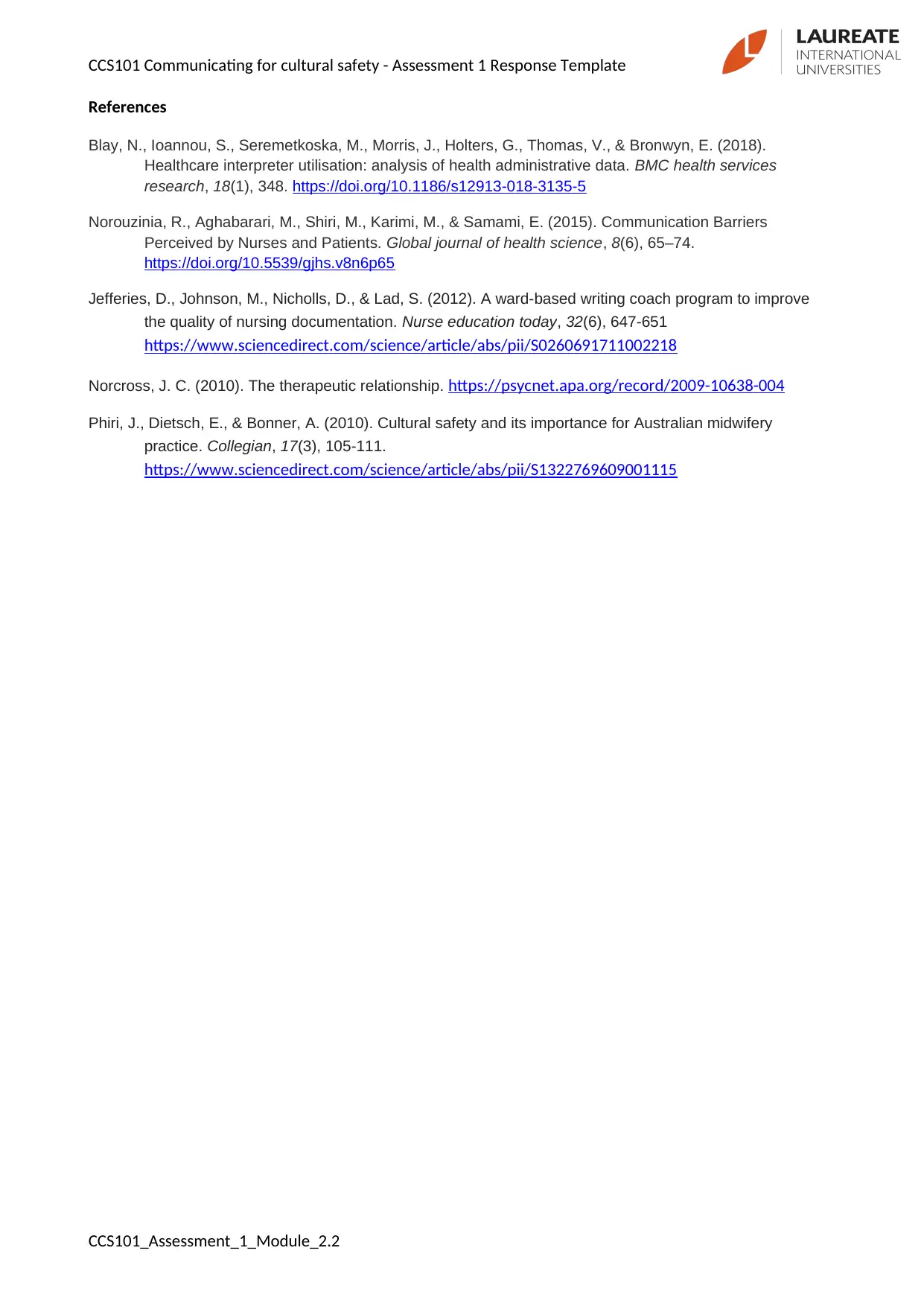
CCS101 Communicating for cultural safety - Assessment 1 Response Template
References
Blay, N., Ioannou, S., Seremetkoska, M., Morris, J., Holters, G., Thomas, V., & Bronwyn, E. (2018).
Healthcare interpreter utilisation: analysis of health administrative data. BMC health services
research, 18(1), 348. https://doi.org/10.1186/s12913-018-3135-5
Norouzinia, R., Aghabarari, M., Shiri, M., Karimi, M., & Samami, E. (2015). Communication Barriers
Perceived by Nurses and Patients. Global journal of health science, 8(6), 65–74.
https://doi.org/10.5539/gjhs.v8n6p65
Jefferies, D., Johnson, M., Nicholls, D., & Lad, S. (2012). A ward-based writing coach program to improve
the quality of nursing documentation. Nurse education today, 32(6), 647-651
https://www.sciencedirect.com/science/article/abs/pii/S0260691711002218
Norcross, J. C. (2010). The therapeutic relationship. https://psycnet.apa.org/record/2009-10638-004
Phiri, J., Dietsch, E., & Bonner, A. (2010). Cultural safety and its importance for Australian midwifery
practice. Collegian, 17(3), 105-111.
https://www.sciencedirect.com/science/article/abs/pii/S1322769609001115
CCS101_Assessment_1_Module_2.2
References
Blay, N., Ioannou, S., Seremetkoska, M., Morris, J., Holters, G., Thomas, V., & Bronwyn, E. (2018).
Healthcare interpreter utilisation: analysis of health administrative data. BMC health services
research, 18(1), 348. https://doi.org/10.1186/s12913-018-3135-5
Norouzinia, R., Aghabarari, M., Shiri, M., Karimi, M., & Samami, E. (2015). Communication Barriers
Perceived by Nurses and Patients. Global journal of health science, 8(6), 65–74.
https://doi.org/10.5539/gjhs.v8n6p65
Jefferies, D., Johnson, M., Nicholls, D., & Lad, S. (2012). A ward-based writing coach program to improve
the quality of nursing documentation. Nurse education today, 32(6), 647-651
https://www.sciencedirect.com/science/article/abs/pii/S0260691711002218
Norcross, J. C. (2010). The therapeutic relationship. https://psycnet.apa.org/record/2009-10638-004
Phiri, J., Dietsch, E., & Bonner, A. (2010). Cultural safety and its importance for Australian midwifery
practice. Collegian, 17(3), 105-111.
https://www.sciencedirect.com/science/article/abs/pii/S1322769609001115
CCS101_Assessment_1_Module_2.2
1 out of 11
Related Documents
Your All-in-One AI-Powered Toolkit for Academic Success.
+13062052269
info@desklib.com
Available 24*7 on WhatsApp / Email
![[object Object]](/_next/static/media/star-bottom.7253800d.svg)
Unlock your academic potential
Copyright © 2020–2025 A2Z Services. All Rights Reserved. Developed and managed by ZUCOL.





